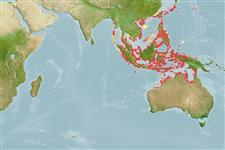>
Ovalentaria/misc (Various families in series Ovalentaria) >
Pomacentridae (Damselfishes) > Pomacentrinae
Etymology: Amphiprion: Greek, amphi = on both sides + Greek, prion, -onos = saw (Ref. 45335).
Environment: milieu / climate zone / depth range / distribution range
Ecología
marino asociado a arrecife; no migratorio; rango de profundidad 1 - 12 m (Ref. 7247). Tropical; 30°N - 20°S, 91°E - 143°E
Western Pacific: Gulf of Thailand to southwestern Palau, north to southern Japan, south to Java, Indonesia.
Tamaño / Peso / Age
Maturity: Lm ? range ? - ? cm
Max length : 14.0 cm TL macho / no sexado; (Ref. 9710)
Short description
Claves de identificación | Morfología | Morfometría
Espinas dorsales (total) : 9 - 10; Radios blandos dorsales (total) : 16 - 18; Espinas anales: 2; Radios blandos anales: 13 - 15.
Found in lagoon reefs and embayment. Monogamous (Ref. 52884), protandrous hermaphrodite (Ref. 55367). Oviparous, distinct pairing during breeding (Ref. 205). Eggs are demersal and adhere to the substrate (Ref. 205). Males guard and aerate the eggs (Ref. 205). Associated with the anemone Entacmaea quadricolor (Ref. 5911). Has been reared in captivity (Ref. 35413, 35415, 35418, 35420).
Life cycle and mating behavior
Maturities | Reproducción | Spawnings | Egg(s) | Fecundities | Larva
Benthic spawner. Length at sex change = 6.6 cm TL (Ref. 55367). Oviparous, distinct pairing during breeding (Ref. 205). Eggs are demersal and adhere to the substrate (Ref. 205). Males guard and aerate the eggs (Ref. 205). Monogamous mating is observed as both obligate and social (Ref. 52884). Also Ref. 240, 7471.
Fautin, D.G. and G.R. Allen, 1992. Field guide to anemonefishes and their host sea anemones. Western Australian Museum, Francis Street, Perth. (Ref. 5911)
IUCN Red List Status (Ref. 130435)
Threat to humans
Harmless
Human uses
Pesquerías: comercial; Acuario: Comercial
Herramientas
Special reports
Download XML
Fuentes de Internet
Estimates based on models
Preferred temperature (Ref.
123201): 25.4 - 29.1, mean 28.7 °C (based on 1412 cells).
Phylogenetic diversity index (Ref.
82804): PD
50 = 0.5000 [Uniqueness, from 0.5 = low to 2.0 = high].
Bayesian length-weight: a=0.02344 (0.01149 - 0.04783), b=2.99 (2.82 - 3.16), in cm total length, based on LWR estimates for this (Sub)family-body shape (Ref.
93245).
Nivel trófico (Ref.
69278): 2.7 ±0.29 se; based on food items.
Resiliencia (Ref.
120179): Alto, población duplicada en un tiempo mínimo inferior a 15 meses (Preliminary K or Fecundity.).
Fishing Vulnerability (Ref.
59153): Low vulnerability (10 of 100).
Nutrients (Ref.
124155): Calcium = 98.6 [50.4, 156.3] mg/100g; Iron = 0.719 [0.433, 1.170] mg/100g; Protein = 18.3 [17.1, 19.4] %; Omega3 = 0.1 [0.1, 0.2] g/100g; Selenium = 20.7 [11.8, 39.1] μg/100g; VitaminA = 82 [23, 267] μg/100g; Zinc = 1.68 [1.14, 2.42] mg/100g (wet weight);
